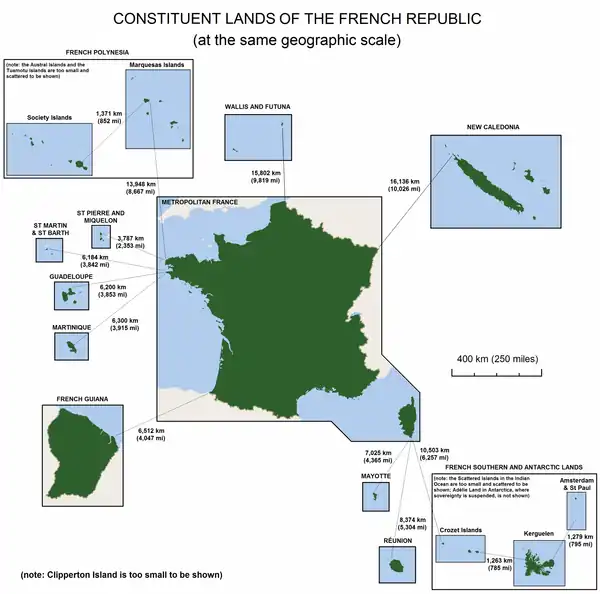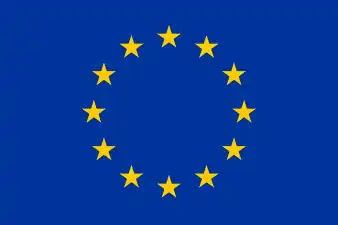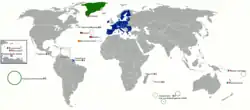Overseas France
Overseas France (French: France d'outre-mer)[note 4] consists of 13 French-administered territories outside Europe, mostly the remains of the French colonial empire that remained a part of the French state under various statuses after decolonization. Some, but not all, are part of the European Union. "Overseas France" is a collective name; while used in everyday life in France, it is not an administrative designation in its own right. Instead, the five overseas regions have exactly the same administrative status as the metropolitan regions; the five overseas collectivities are semi-autonomous; and New Caledonia is an autonomous territory. Overseas France includes island territories in the Atlantic, Pacific and Indian Oceans, French Guiana on the South American continent, and several peri-Antarctic islands as well as a claim in Antarctica. Excluding the district of Adélie Land, where French sovereignty is effective de jure by French law, but where the French exclusive claim on this part of Antarctica is frozen by the Antarctic Treaty (signed in 1959), overseas France covers a land area of 120,396 km2 (46,485 sq mi)[5] and accounts for 18.0% of the French Republic's land territory.[6] Its exclusive economic zone (EEZ) of 9,825,538 km2 (3,793,661 sq mi) accounts for 96.7% of the EEZ of the French Republic.[7]
Overseas France | |
|---|---|
| Motto: "Liberté, égalité, fraternité" "Liberty, Equality, Fraternity" | |
| Anthem: La Marseillaise ("The Marseillaise") | |
Great Seal: .svg.png.webp) | |
.svg.png.webp) Territory of the French Republic (red) Overseas territories (circled) Claimed territory (Adélie Land; hatched) | |
 | |
| Capital | Paris |
| Largest settlements | Fort-de-France (Martinique), Pointe-à-Pitre (Guadeloupe), Saint Denis (La Réunion), Saint Pierre (La Réunion), Nouméa (New Caledonia) |
| Languages | French, Antillean Creole, Guianan Creole, Reunionese Creole, Shimaore, Tahitian, Marquesan, 'Uvean, Futunan, Drehu, Nengone, Paicî, Ajië, Javanese, and 35 other native languages of New Caledonia |
| Demonym(s) | French |
| Territories | |
| Leaders | |
| Emmanuel Macron | |
• Minister | Philippe Vigier |
| Area | |
• Total | 120,396[note 3] km2 (46,485 sq mi) |
| Population | |
• Estimate | 2,816,000 (Jan. 2023) |
| Currency | Euro CFP Franc |
| Date format | dd/mm/yyyy (AD) |
| This article is part of a series on the |
| Administrative divisions of France |
|---|
 |
| Administrative divisions |
| Intercommunality |
| Communes |
| Overseas France |
| Geocodes of France |
|
|
|
|
Outside of Europe, four broad classes of overseas French territorial administration currently exist: overseas departments/regions, overseas collectivities, the sui generis territory of New Caledonia, and uninhabited territories. From a legal and administrative standpoint, these four classes have varying legal status and levels of autonomy, although all permanently inhabited territories have representation in both France's National Assembly and Senate, which together make up the French Parliament.
2,816,000 people lived in overseas France in January 2023.[8] Most of these residents are citizens of France and citizens of the European Union. This makes them able to vote in French and European elections.
Varying constitutional statuses
Overseas regions and departments
| Year | Pop. | ±% |
|---|---|---|
| 1950 | 847,000 | — |
| 1960 | 1,103,000 | +30.2% |
| 1970 | 1,388,000 | +25.8% |
| 1980 | 1,582,000 | +14.0% |
| 1990 | 1,921,000 | +21.4% |
| 2000 | 2,295,000 | +19.5% |
| 2010 | 2,622,000 | +14.2% |
| 2020 | 2,782,000 | +6.1% |
| 2023 | 2,816,000 | +1.2% |
| January 2023: Total population of all overseas departments and collectivities: 2,816,000. Total population of five overseas departments: 2,208,000.[9] Total population of six overseas collectivities: 608,000. Sources: French Polynesia,[10] New Caledonia,[11] Saint Barthélemy,[12] Saint Martin,[12] Saint Pierre and Miquelon,[12] Wallis et Futuna[13] | ||
Overseas regions have exactly the same status as France's mainland regions. The French Constitution provides that, in general, French laws and regulations (France's civil code, penal code, administrative law, social laws, tax laws, etc.) apply to French overseas regions just as in metropolitan France, but can be adapted as needed to suit the region's particular needs. Hence, the local administrations of French overseas regions cannot themselves pass new laws.
- French Guiana (since 1946)
- Guadeloupe (since 1946)
- Martinique (since 1946)
- Mayotte (since 2011) 1976–2003: sui generis overseas territory; 2001–2003: with the designation departmental community; 2003–2011: overseas community. In the 2009 Mahoran status referendum, Mahorans voted to become an overseas department in 2011, which occurred on 31 March 2011.
- Réunion (since 1946)
Overseas collectivities
The category of "overseas collectivity" (French: collectivité d'outre-mer or COM) was created by France's constitutional reform of 28 March 2003. Each overseas collectivity has its own statutory laws.
In contrast to overseas departments/regions, the overseas collectivities are empowered to make their own laws, except in certain areas reserved to the French national government (such as defense, international relations, trade and currency, and judicial and administrative law). The overseas collectivities are governed by local elected assemblies and by the French Parliament and French Government, with a cabinet member, the Minister of the Overseas, in charge of issues related to the overseas territories.
- French Polynesia (1946–2003: overseas territory, since 2003: overseas collectivity) In 2004 it was given the designation of "overseas country" (French: pays d'outre-mer), but the Constitutional Council of France has clarified that this designation did not create a new political category.
- Saint Barthélemy: In 2003, Saint-Barthélemy voted to become an overseas collectivity of France. Saint-Barthélemy is not part of the European Union, having changed the status to an overseas country or territory associated with the European Union in 2012.
- Saint Martin: In 2003, the populations of Saint-Martin voted in favour of secession from Guadeloupe in order to become separate overseas collectivity of France.[14] On 7 February 2007, the French Parliament passed a bill granting COM status to both jurisdictions.[15] The new status took effect on 22 February 2007 when the law was published in the Journal Officiel.[16] Saint-Martin remains part of the European Union, as stated in the Treaty of Lisbon.[17]
- Saint Pierre and Miquelon (1976–85: overseas department, 1985–2003: sui generis overseas territory, since 2003: overseas collectivity). Despite being given the political status of "overseas collectivity," Saint Pierre et Miquelon is called collectivité territoriale de Saint-Pierre-et-Miquelon, literally "territorial collectivity."
- Wallis and Futuna (1961–2003: overseas territory, since 2003: overseas collectivity). It is still commonly referred to as a territoire (Territoire des îles Wallis et Futuna).
Sui generis collectivity
- New Caledonia had the status of an overseas territory from 1946 to 1998, but as of the 1998 Nouméa Accord it gained a special status (statut particulier or sui generis) in 1999. A New Caledonian citizenship was established (in addition to the French citizenship which is kept in parallel, along with the European citizenship), and a gradual transfer of power from the French state to New Caledonia itself was begun, to last from 15 to 20 years.[18]
However, this process was subject to approval in a referendum. Three independence referendums have been held, in 2018, 2020 and 2021. In the third referendum, in December 2021, 96.5% rejected independence but the turnout was only 43.9%. In the two earlier referendums the "no" vote was 57% and 53% respectively.[19]
The future status within France of New Caledonia will now be the subject of a further referendum to be held before the end of 2023.[20]
Overseas territory
- French Southern and Antarctic Lands (Terres Australes et Antarctiques Françaises or TAAF); overseas territory of France (since 1956). It is currently the only overseas territory. According to law 2007-224 of 21 February 2007, the Scattered Islands in the Indian Ocean constitute the 5th district of TAAF.
Special status
- Clipperton Island (French: Île de Clipperton or Île de la Passion; Spanish: Isla de la Pasión) is a 9 km2 (3.5 sq mi) uninhabited coral atoll located 1,280 km (800 miles) south-west of Acapulco, Mexico in the Pacific Ocean. It is held as an overseas "state private property" under the direct authority of the French government, and is administered by France's Overseas Minister. ("Private" in this context refers to official restrictions on access, rather than private ownership per se.)
Political representation in legislatures

With 2,816,000 inhabitants in 2023, overseas France accounts for 4.1% of the population of the French Republic.[8] They enjoy a corresponding representation in the two chambers of the French Parliament and in the 16th legislature of the French Fifth Republic (2022-2027) overseas France is represented by 27 deputies in the French National Assembly, accounting for 4.7% of the 577 deputies in the National Assembly:
- Réunion: 7
- Guadeloupe: 4
- Martinique: 4
- French Polynesia: 3
- French Guiana: 2
- Mayotte: 2
- New Caledonia: 2
- Saint Barthélemy and Saint Martin: 1
- Saint Pierre and Miquelon: 1
- Wallis and Futuna: 1
 Senate (France)
Senate (France)
Since September 2011, overseas France has been represented by 21 senators in the French Senate, accounting for 6.0% of the 348 senators in the Senate:
- Réunion: 4
- Guadeloupe: 3
- French Guiana: 2
- French Polynesia: 2
- Martinique: 2
- Mayotte: 2
- New Caledonia: 2
- Saint Barthélemy: 1
- Saint Martin: 1
- Saint Pierre and Miquelon: 1
- Wallis and Futuna: 1
 European Parliament (European Union)
European Parliament (European Union)
The territories used to be collectively represented in the European Parliament by the Overseas Territories of France constituency. Since the 2019 European elections, France decided to switch to a single constituency, putting an end to all regional constituencies, including the Overseas Territories constituency.
 Council (European Union)
Council (European Union)
The special territories of EU Member states are not separately represented in the EU Council. Every member state represents all its citizens in the Council.
Overview
Inhabited departments and collectivities
The eleven inhabited French overseas territories are:
| Flag[note 5] | Name | Capital | Population | Land area (km2) | Population density (inh. per km2) | Status | Location | Notes |
|---|---|---|---|---|---|---|---|---|
| French Guiana | Cayenne | 301,099 (Jan. 2023)[9] |
83,534[21] | 3.6 | Overseas department / region | The Guianas, South America | ||
| French Polynesia | Papeete | 278,786 (Aug. 2022)[10] |
3,521[22] | 79 | Overseas collectivity | Polynesia, South Pacific | ||
| Guadeloupe | Basse-Terre | 375,845 (Jan. 2023)[9] |
1,628[21] | 231 | Overseas department / region | Caribbean, North Atlantic | ||
| Martinique | Fort-de-France | 347,686 (Jan. 2023)[9] |
1,128[21] | 308 | ||||
| Mayotte | Mamoudzou | 310,022 (Jan. 2023)[9] |
374[22] | 829 | Mozambique Channel, Indian Ocean | Voted on 29 March 2009, in favour of attaining overseas department / region status. That status became effective on March 31, 2011. Also claimed by the Comoros. | ||
| New Caledonia | Nouméa | 269,808 (Jan. 2022)[11] |
18,575.5[23] | 14.5 | Sui generis collectivity | Melanesia, South Pacific | Independence referendums occurred on 4 November 2018 (56.4% voting against and 43.6% voting in favor), as well as on 4 October 2020 (53.3% voting against and 46.7% voting in favor). A third and final one held in December 2021 rejected independence (96.5% voting against and 3.5% voting in favor).[24] | |
| Réunion | Saint Denis | 873,102 (Jan. 2023)[9] |
2,504[21] | 349 | Overseas department / region | Mascarene Islands, Indian Ocean | ||
| Saint Barthélemy | Gustavia | 9,961 (Jan. 2017[note 6])[25] |
25[note 7][26] | 398 | Overseas collectivity | Caribbean, North Atlantic | Detached from Guadeloupe on 22 February 2007. | |
| Saint Martin | Marigot | 32,358 (Jan. 2020)[12] |
53[27] | 611 | ||||
| Saint Pierre and Miquelon | Saint Pierre | 6,092 (Jan. 2020)[12] |
242[22] | 25 | Gulf of St. Lawrence, North Atlantic | |||
| Wallis and Futuna | Mata Utu | 11,558 (Jul. 2018[note 8])[13] |
142[22] | 81 | Polynesia, South Pacific | |||
Uninhabited overseas territories
Several of these territories are generally only transiently inhabited by researchers in scientific stations.
| Flag | Name | District | Scattered islands | Capital | Land area (km2) | Status | Location | Notes |
|---|---|---|---|---|---|---|---|---|
| Clipperton Island | – | – | – | 2[28] | Overseas state private property | North Pacific | ||
| French Southern and Antarctic Lands | Adélie Land | – | Dumont d'Urville Station | 432,000[29] | TAAF district | Antarctica | Under the terms of the Antarctic Treaty. | |
| Crozet Islands | – | Alfred Faure | 340[29] | Indian Ocean | ||||
| Kerguelen Islands | – | Port-aux-Français | 7,215[29] | Population: 45 researchers in winter, 110 in summer. | ||||
| Saint Paul and Amsterdam Islands |
– | Martin-de-Viviès | 66[29] | |||||
| Scattered Islands in the Indian Ocean | Banc du Geyser | – | 0 | Mozambique Channel | Claimed by the Comoros and Madagascar. | |||
| Bassas da India | – | 1[29] | Claimed by Madagascar. | |||||
| Europa Island | – | 30[29] | ||||||
| Glorioso Islands | – | 7[29] | Indian Ocean | Claimed by the Comoros and Madagascar. | ||||
| Juan de Nova Island | – | 5[29] | Mozambique Channel | Claimed by Madagascar. | ||||
| Tromelin Island | – | 1[29] | Indian Ocean | Claimed by Mauritius. |
Map

Largest cities in overseas France
Ranked by population in the metropolitan area:
- Saint Denis (Réunion): 315,080 (in 2020)
- Pointe-à-Pitre–Les Abymes (Guadeloupe): 312,630 (in 2020)
- Saint Pierre–Le Tampon (Réunion): 222,614 (in 2020)
- Nouméa (New Caledonia): 182,341 (in 2019)
- Saint Paul (Réunion): 171,109 (in 2020)
- Cayenne (French Guiana): 151,887 (in 2020)
- Papeete (French Polynesia): 138,861 (in 2022)
- Fort-de-France (Martinique): 130,115, inhabitants (in 2023)
See also
- 2009 Mahoran status referendum
- Administrative divisions of France
- Communes of France
- French colonial empire
- Government of France
- List of French possessions and colonies
- List of islands administered by France in the Indian and Pacific oceans
- Metropolitan France
- Organisation internationale de la Francophonie
- Outre-mer
- Overseas collectivity
- Overseas department and region
- Overseas military bases of France
- Overseas Territories of France (European Parliament constituency)
- Overseas territory
- Special member state territories and the European Union
- Volontaire Civil à l'Aide Technique
- French claims in Jerusalem:
Notes
- The current Constitution of France does not specify a national emblem.[1] This emblem is used by the President, Ministry for Europe and Foreign Affairs,[2] and is on the cover of French passports. For other symbols, see National symbols of France.
- The current Constitution of France does not specify a national emblem.[3] This emblem is used by the President, Ministry for Europe and Foreign Affairs,[4] and is on the cover of French passports. For other symbols, see National symbols of France.
- Excluding Adélie Land.
- Also les Outre-mer, les outre-mers, or colloquially les DOM-TOM (départements d'outre-mer et territoires d'outre-mer) or les DROM-COM (départements et régions d'outre-mer et collectivités d'outre-mer).
- Article 2 of the French Constitution states that the French Flag is the only legal flag of France. Only French Polynesia, an overseas country, and New Caledonia, a special collectivity are allowed to have their official flags. This right was granted to French Polynesia by a 6 September 1984, law and to New Caledonia by the Nouméa Accord. The Administrator of French Antarctica is also granted his own flag through a 23 February 2007 ordinance. Historical flags are sometimes used but have no basis in law. Many territories use unofficial flags to represent the territories. The unofficial flags are shown in this table.
- Last published population census in January 2017. The next population census in Saint Barthélemy took place in January-February 2023 but its results haven't been published yet.
- 25 km² including the outlying uninhabited islets. 21 km² without the outlying islets.
- Last population census in July 2018. The next population census in Wallis and Futuna will take place in 2023.
References
- Article II of the Constitution of France (1958)
- "The lictor's fasces". elysee.fr. 20 November 2012.
- Article II of the Constitution of France (1958)
- "The lictor's fasces". elysee.fr. 20 November 2012.
- Larousse, Éditions. "Encyclopédie Larousse en ligne - France d'outre-mer". www.larousse.fr (in French). Retrieved 2 October 2022.
- Land area of the four old overseas departments (), Mayotte, the overseas collectivities, and New Caledonia (page 21), the French Southern and Antarctic Lands and the Scattered Islands ( Archived 19 June 2018 at the Wayback Machine), and Clipperton ( Archived 5 March 2020 at the Wayback Machine).
- "Sea Around Us – Fisheries, Ecosystems and Biodiversity". Retrieved 20 June 2018.
- The population of all five overseas departments totaled 2,208,000 in January 2023. The population of the overseas collectivities amounted to 608,000 inhabitants (Saint-Pierre and Miquelon , Saint-Barthélemy , Saint-Martin , French Polynesia , Wallis et Futuna , New Caledonia ). The total population of the overseas departments and territories of France is estimated at 2,816,000.
- "Estimation de population par région, sexe et grande classe d'âge - Années 1975 à 2023". INSEE. Retrieved 8 March 2023.
- "Les populations légales de Polynésie française en 2022 - Recensement de la population" (in French). Institut national de la statistique et des études économiques. Archived from the original on 9 March 2023. Retrieved 8 March 2023.
- "Bilan démographique 2020-2021: une dynamique démographique en berne dans un contexte atypique". Institut national de la statistique et des études économiques Nouvelle-Calédonie. Retrieved 8 March 2023.
- "Populations légales des collectivités d'outre-mer en 2020 - Recensement de la population" (in French). Institut national de la statistique et des études économiques. Retrieved 8 March 2023.
- "Populations légales des circonscriptions des îles Wallis et Futuna en 2018 - Recensement de la population" (in French). Institut national de la statistique et des études économiques. Retrieved 8 March 2023.
- "French Caribbean voters reject change". Caribbean Net News. 9 December 2003. Archived from the original on 18 March 2009. Retrieved 9 February 2007.
However, voters in the two tiny French dependencies of Saint-Barthélemy and Saint-Martin, which have been administratively attached to Guadeloupe, approved the referendum and are set to acquire the new status of "overseas collectivity".
- Magras, Bruno (16 February 2007). "Letter of Information from the Mayor to the residents and non-residents, to the French and to the foreigners, of Saint Barthelemy" (PDF). St. Barth Weekly. p. 2. Retrieved 18 February 2007.
On 7 February of this year, the French Parliament adopted the law granting Saint-Barthélemy the Statute of an Overseas Collectivity.
- "Saint-Barth To Become An Overseas Collectivity" (PDF). St. Barth Weekly. 9 February 2007. p. 2. Retrieved 9 February 2007.
- "Treaty of Lisbon, Article 2, points 287 and 293". Retrieved 31 January 2008.
- "Nouvelle-Calédonie", Le Petit Larousse (2010), Paris, page 1559.
- "Final results of New Caledonia referendum shows most voters stayed away". Reuters. 13 December 2021. Retrieved 13 December 2021.
- "'Tonight France is more beautiful': Macron hails New Caledonia's rejection of independence". France 24. 13 December 2021. Retrieved 13 December 2021.
- INSEE. "Comparateur de territoire" (in French). Retrieved 29 January 2021.
- INSEE. "Tableau Économique de Mayotte 2010" (PDF) (in French). p. 21. Retrieved 29 January 2021.
- ISEE. "Tableaux de l'Economie Calédonienne 2016" (in French). p. 31. Retrieved 29 January 2021.
- Rose, Michel; Packham, Colin (12 December 2021). "New Caledonia rejects independence in final vote amid boycott". Reuters.
- "Populations légales 2017 des départements et collectivités d'outre-mer". INSEE (in French). Government of France. Retrieved 29 January 2021.
- INSEE. "2008, An 1 de la collectivité de Saint-Barthélemy" (PDF) (in French). p. 7. Retrieved 29 January 2021.
- INSEE. "2008, An 1 de la collectivitéde Saint-Martin" (PDF) (in French). p. 6. Retrieved 29 January 2021.
- Ministry of Overseas France. "L'île de Clipperton" (in French). Retrieved 31 January 2014.
- Délégation générale à l'outre-mer. "Terres Australes et Antarctiques Françaises : Données géographiques et humaines" (PDF) (in French). Archived from the original (PDF) on 2 February 2014. Retrieved 31 January 2014.
Further reading
- Robert Aldrich and John Connell, France's Overseas Frontier, Cambridge University Press, 1992.
- Frédéric Monera, L'idée de République et la jurisprudence du Conseil constitutionnel, Paris: L.G.D.J., 2004.
